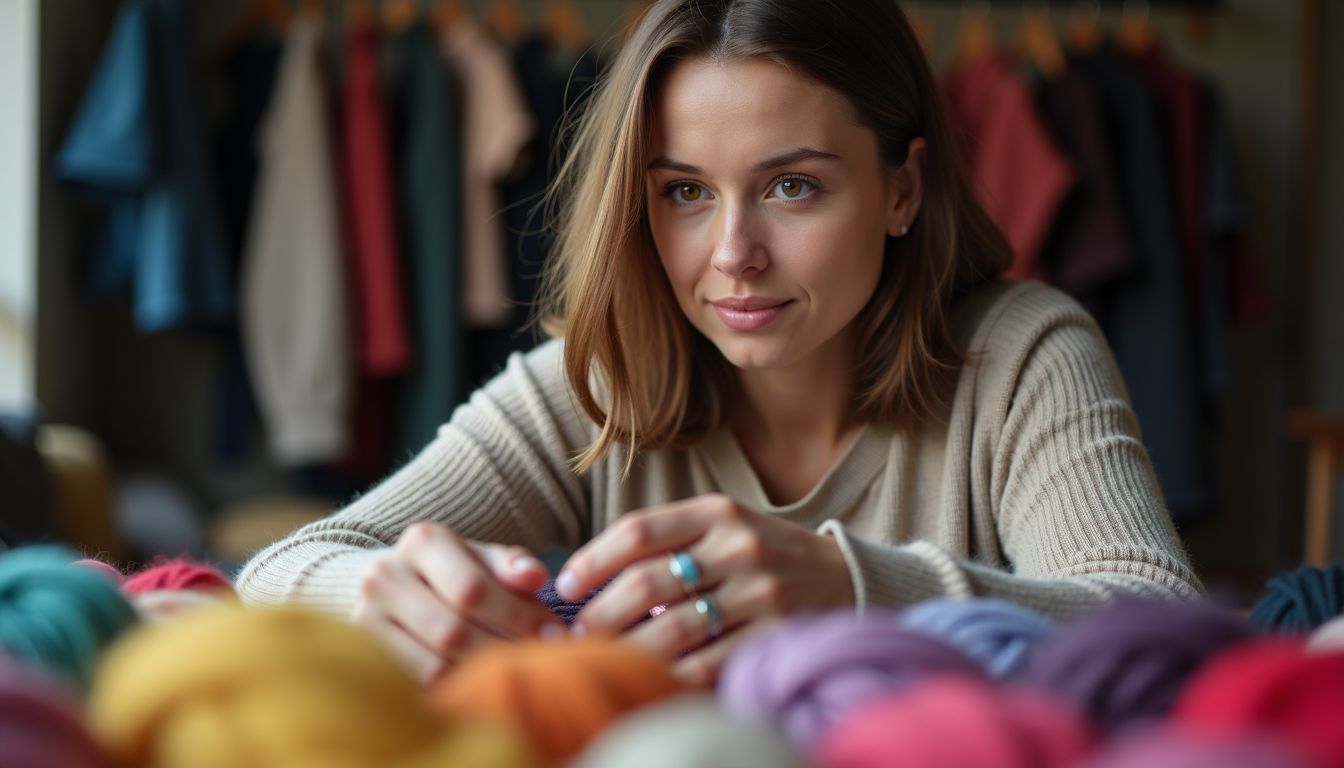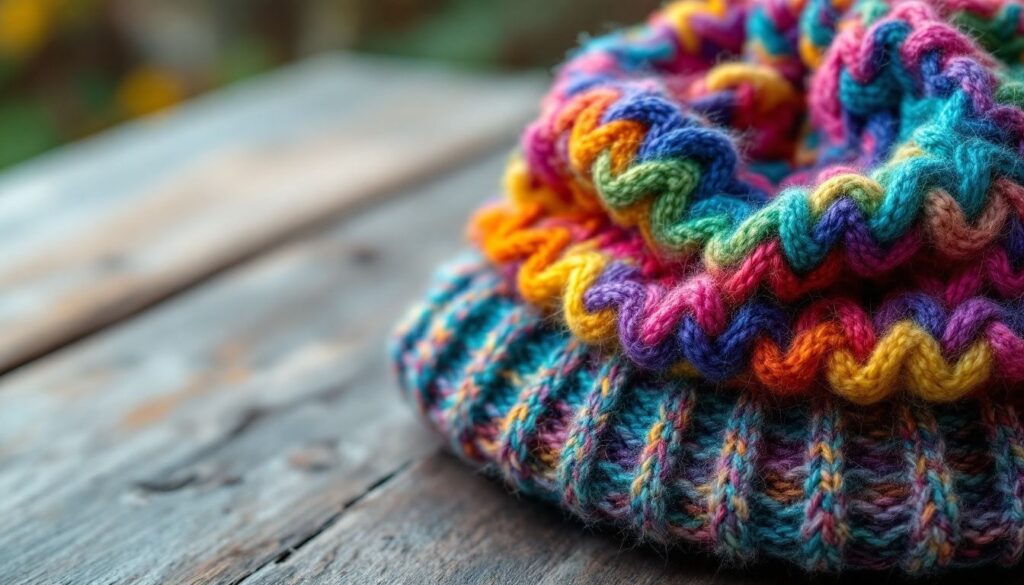Many people love fashion and want to make their clothes and accessories stand out. One way to do this is by using tufting fonalak to add texture to fashion accessories. This method brings a unique look and feel to items like bags, scarves, and hats.
A fact about tufting is that it can greatly enhance the visual appeal of accessories, making them more eye-catching.
The choice of yarn color plays a big role in how these tufted pieces look. Picking the right colors can be hard with so many options out there. This article will give tips on choosing the perfect yarn colors for your projects.
Get ready for some creative ideas!
Tartalomjegyzék
ToggleImportance of Yarn Color Palette in Tufted Fashion Accessories

Choosing the right yarn color palette is key for tufted fashion accessories. It sets the mood and style, making each piece stand out.
Understanding the Impact of Color Choices
Colors used in bolyhosító fonal critically influence fashion accessories. They have the potency to evoke specific emotions. Tranquil colors such as blue and green induce serenity, while cozy colors like red, orange, and yellow bring warmth and encourage interaction.
Moreover, these colors can emphasize varying parts of a design, enabling the designer to transmit their personal style.
Samuel Davity has observed the transformative effect of a well-chosen color palette on the aesthetic appeal of an accessory. He applies his knowledge to select colors that complement and also establish the appropriate ambiance for every piece.
This illustrates the significant role of color choice in making tufted items distinctive and conveying a singular message.
Factors to Consider When Choosing Tufting Yarn Colors
Choosing the right bolyhosító fonal colors is key to creating stunning fashion accessories. These choices affect the project’s overall look and feel.
- Project type and goal: Understand what you’re making and the effect you want. For vibrant outfits, pick colors that match.
- Color psychology: Colors carry meanings. Red adds excitement, blue brings calm, green means nature, and yellow shines with optimism.
- Existing color scheme: Make sure your yarn matches the outfit’s colors to add elegance.
- Mixing colors: Combining different hues can make your accessory stand out.
- Personal taste: Your choice reflects your personality. Pick yarns that speak to you.
- Mood board creation: Put together a board with colors and images for inspiration.
- Observe color interactions: Look at how colors work together before deciding.
- Assess proportions: Think about how much of each color you’ll use; balance is key.
- Color temperatures: Warm and cool tones can change a piece’s feel; choose wisely.
- Test swatches: Work with yarn samples to see how they look in real life.
- Nature inspiration: The outdoors has a wide range of colors to inspire your palette.
- Trust instincts but remain flexible: Go with what feels right but be open to change.
- Seek feedback: Get opinions from others; it can help refine your choices.
Next, we will explore tips for picking the perfect tufting yarn color palette based on these factors.
Tips for Choosing the Perfect Tufting Yarn Color Palette
Selecting the right tufting yarn color palette can make your fashion accessories pop. Look at your mood board and play with different yarn swatches to see what colors work best together.
Creating a Mood Board
Creating a mood board starts with gathering inspirational items. People pick pictures, fabric swatches, and paint samples that catch their eye. They collect these based on a design theme they like.
This helps them visualize the color scheme and texture selection for their tufting project.
They then lay out these visual elements to see how the colors work together. This process is key in creating the right mood for their fashion accessory. It’s not just about looking good; it’s about feeling right too.
A mood board brings your creative vision to life.
Observing Color Interactions
After setting up a mood board, Samuel Davity moves to observe how colors work together. He watches color interactions closely because they set the tone for his tufting projects. Different color combinations can change how people feel about an accessory.
His experience shows that mixing colors in various ratios can alter the mood of any piece. This is why he experiments with different proportions before deciding on a final palette.
Samuel plans his color schemes to complement rather than match the primary designs in fashion completely. This approach ensures his tufted pieces stand out while still fitting within broader style trends.
By checking how colors act side by side, he finds unique blends that make his accessories pop. Through this careful observation and experimentation, Samuel creates tufting yarn palettes that add deep texture and flair to fashion accessories, proving coherence and distinction in design are equally important.
Assessing Color Proportions
Assessing color proportions is key to avoiding overwhelming designs. One must pick a dominant color as the main hue. This color sets the mood for the piece. Then, add a few accent colors to create visual interest without clashing.
From personal experience, it’s clear that using too many bright colors can distract from the accessory’s purpose. Instead, balancing dominant and accent hues ensures harmony.
Next step involves understanding how these colors work in different lights. This leads into utilizing color temperatures effectively.
Utilizing Color Temperatures
Colors have temperatures that play a big role in design. Warm colors like red and yellow bring warmth and energy. On the other hand, cool colors like blue and green offer calmness.
Mixing these can make your tufting projects stand out.
Samuel Davity uses both warm and cool hues in his work. He finds blending them creates an eye-catching palette. This mix adds depth to accessories by giving visual appeal and emotional response.
Samuel’s experience shows how important color harmony is in textile color selection.
Testing Yarn Swatches
Testing yarn swatches is a key step before starting a tufting project. Artists look at different yarn colors under both natural and artificial light. This helps them see how colors change in different environments.
It’s important to check colors this way because a color might look one way in sunlight but completely different under a lamp.
Artists also mix and match yarn colors to find the best combinations. They can make changes easily at this stage, without having to commit to the final design. Testing swatches gives artists flexibility during their creative process, allowing for adjustments before finalizing their tufted fashion accessories.
Drawing Inspiration from Nature
Drawing inspiration from nature offers endless color possibilities for tufting yarns. Artists look at flowers, seascapes, and sunsets for vibrant hues. These natural elements show how colors blend smoothly or contrast sharply in the real world.
They think about earthy tones found in soil and plants, oceanic blues from the sea, and bright floral pigments. This approach helps them create tufted fashion accessories that remind people of the beauty outside.
Translating what they see in nature into their projects allows artists to mix unexpected color combinations. They notice how sunlight changes a landscape’s colors throughout the day and use these observations to pick yarns that reflect these shifts.
By bringing natural color schemes into their work, artists make pieces that feel more alive and connected to the environment around us.
Trusting Instincts and Flexibility
Trusting instincts plays a vital role in the creative process of tufting, especially when selecting yarn colors. Samuel Davity, from his experiences at Városi Tufting, knows well that first choices in color might not always fit as the design unfolds.
This understanding has taught him the importance of being ready to adapt and change selections mid-process. The ability to adjust ensures that the final piece truly reflects artistic vision and mood.
Flexibility in design also means accepting that adaptations are part of achieving perfection in textile art. Samuel often finds himself revisiting initial color decisions, realizing along the way how different shades can bring a piece to life or enhance its texture uniquely.
He advises tufting enthusiasts to stay open-minded and allow their creative instincts to guide them through adjustments for better results.
The beauty of tufting lies not just in following a plan but embracing the changes that come with it.
Seeking Opinions and Feedback
Samuel Davity often asks friends and family for their thoughts during his tufting projects. This step brings in fresh ideas and points of view. It shows how outside opinions can add to the design, making it better than before.
Samuel believes that mixing personal style with suggestions from others leads to unique creations.
He knows that feedback is key to success. Gathering insights doesn’t just improve a project; it also opens doors to new inspirations. Samuel uses this approach at Városi Tufting, showing how valuable different perspectives are in artistry.
Next, let’s explore tips for choosing the perfect tufting yarn color palette.
Következtetés
Picking the right color palette in tufting yarns makes fashion accessories pop. These tips help people choose bold or soft colors that match their style. Mood boards, color temperatures, and nature can inspire great designs.
The article shares easy steps to add texture with tufting. Trying out different colors and asking for feedback lead to exciting projects. This approach transforms simple items into unique fashion statements, urging everyone to experiment and enjoy the process of creating with tufting yarns.
GYIK
1. What are tufting yarns and how can they enhance fashion accessories?
Tufting yarns are a type of thread used in the creation of textiles, known for their unique texture. They can be used to add an element of textural flair to fashion accessories, making them stand out.
2. How do I use tufting yarns on my fashion accessories?
Begin by selecting your desired accessory and tufting yarn color or style. Next, you’ll need a tool like a needle or loom to weave the yarn into the fabric of your accessory. Remember, this is just guidance; feel free to apply your own creativity!
3. Can I use any kind of tufting yarn for enhancing my accessories?
While there’s no limit on what kind you can use, some may work better than others depending on the accessory’s material and design. It’s important to balance aesthetics with utility when choosing your tufting yarn.
4. Are there other ways besides weaving that I can incorporate Tufting Yarns into my designs?
Absolutely! You could create tassels, fringes or pom poms using these textured threads as well as embroider patterns onto fabrics with them – all adding up to an increased visual appeal.

